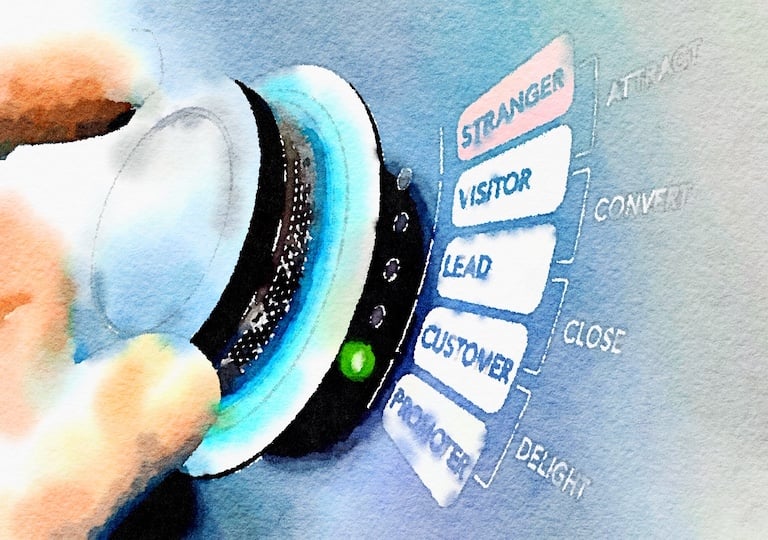“Inbound marketing is a business methodology that attracts customers by creating valuable content and experiences tailored to them. While outbound marketing interrupts your audience with content they don’t want, inbound marketing forms connections they’re looking for and solves problems they already have.”
– HubSpot
For many (if not most) businesses today, traditional marketing simply doesn’t work.
It’s expensive, impersonal, arbitrary, and usually ineffective, with an ROI that decreases every year.
Chances are, when you think about marketing, you’re envisioning outbound marketing. Traditional ad placements, digital advertising, sponsorships, press releases, billboards, purchased lists to make cold calls – all of the purely promotional tactics that hawk your products and services.
Many people think that this is the sum of what marketing amounts to: buying some form of exposure. It’s why marketing is commonly seen as a cost center. And it’s why so many company leaders hate marketing.
A marketing approach focused purely around different forms of advertising – the all-too-typical marketing strategy for many companies – rarely works in our digital age.
In our technologically driven world, consumers are flooded with messages. Recent scientific research shows that the human brain is bombarded daily with 34 GB of information, enough to overload a laptop within a week. And the information deluge is only getting worse.
To preserve our sanity, we’ve all had to become experts at tuning out the noise. The easiest information to dismiss is pushy, impersonal marketing. That’s why over half of us (57 percent) are actively taking steps to avoid brands that bombard us with poorly targeted outreach, according to research from the Aimia Insititute.
People don’t want to be sold to. They’ll run from you when you try. The more you push, the more people resist. No wonder that, worldwide, 380 million mobile devices now have ad-blocking technology installed.
What works today is inbound marketing. The problem is that many businesses don’t even know what inbound is.

What is inbound marketing?
People gravitate to information that provides genuine value. That’s the essence of inbound marketing – when consumers are organically drawn to your brand because of the compelling content or experience you’ve created.
Inbound marketing focuses on generating, nurturing, and converting leads by creating and delivering the right content at the right time. It’s the modern approach to marketing, one which attracts and engages customers by putting their needs first. Over time, companies earn trust by demonstrating their authority around the issues that matter to customers.
Good inbound marketing starts with defining your audience and understanding their problems. How can you become the leading information provider in your field to connect with this audience? How can you create an ongoing conversation that is rooted in education, not promotion?
Inbound content comes in different shapes and sizes – blogs, eBooks, videos, infographics, podcasts, webinars, case studies, conferences …anything that can be a vehicle for a high-quality content experience.
Whatever the form, all content should be tailored to each stage of the buyer’s journey in the sales funnel. Top of the funnel content should create general awareness that introduces you to customers through your expertise around a given subject matter. Middle of the funnel content should focus on increasing engagement with your brand. And bottom of the funnel content should aim to convert leads into customers.
But without advertising, how do customers discover your brand? Customers are drawn to you through social media posts featuring your expert content, guest posts on high authority websites, search engines that elevate your visibility as an authority on topics your customers care about, email marketing that features your content, and numerous other strategies based on your specific buyer personas.
Once customers have a general awareness of who you are, your website becomes a critical platform for nurturing their continued engagement. Doing this requires different inbound tools that capture information about your leads and encourage them to interact with you, including calls to action, landing pages, forms, website analytics, and customer relationship management (CRM) software that is connected to all of your inbound marketing entry points.
Inbound changes your relationship with customers
People are more defensive about their time and attention than ever before. This trend has fostered the rise of the “Deletist Consumer,” the unforgiving customer who blocks all communication with brands that push out irrelevant and impersonal messaging.
Outbound marketing is a costly, uphill climb to grab attention, and the practice yields less than ever before. Thirty-two percent of marketers rank outbound marketing practices, such as paid advertising, as the top waste of time and resources, and the majority (52%) of outbound marketers do not believe their own strategy works.
Alternatively, sixty-eight percent of inbound marketers say their marketing strategy is effective. That’s because inbound marketing alters the dynamic that you have with customers at the very outset, building an exchange of value that earns trust and fosters an ongoing relationship, not just a one-time sale.
The tired old rules of marketing are dead, whether or not the people relying exclusively on these tactics realize it or not. Outbound marketing still has some value, but for most companies it should play a small supporting role. Inbound marketing is more cost-effective, successful, and delightful for everyone involved – and where the future of marketing lies.
![]()
